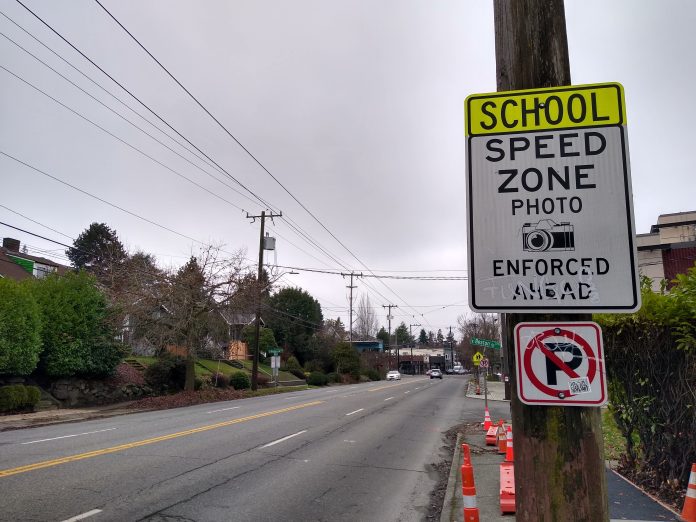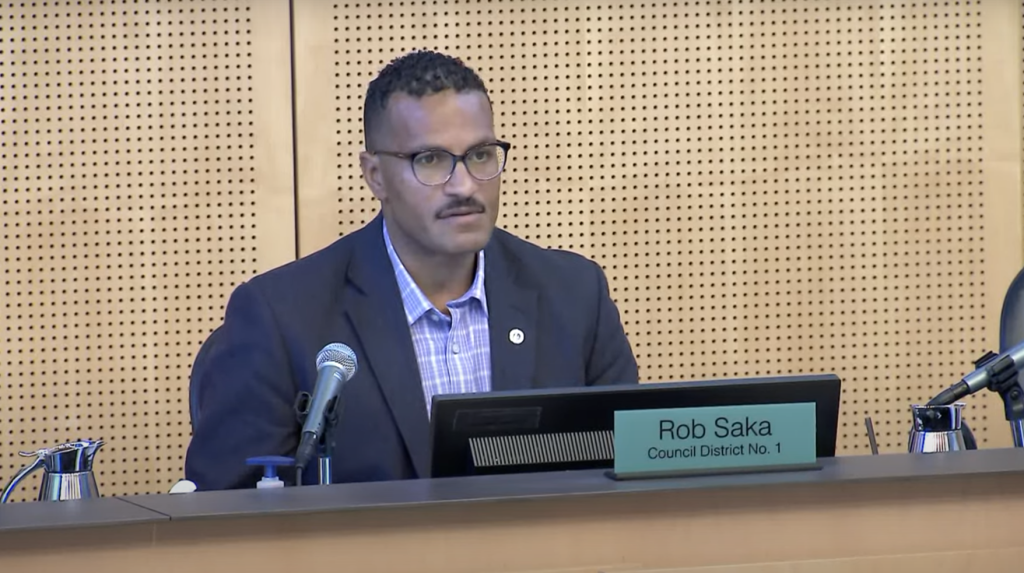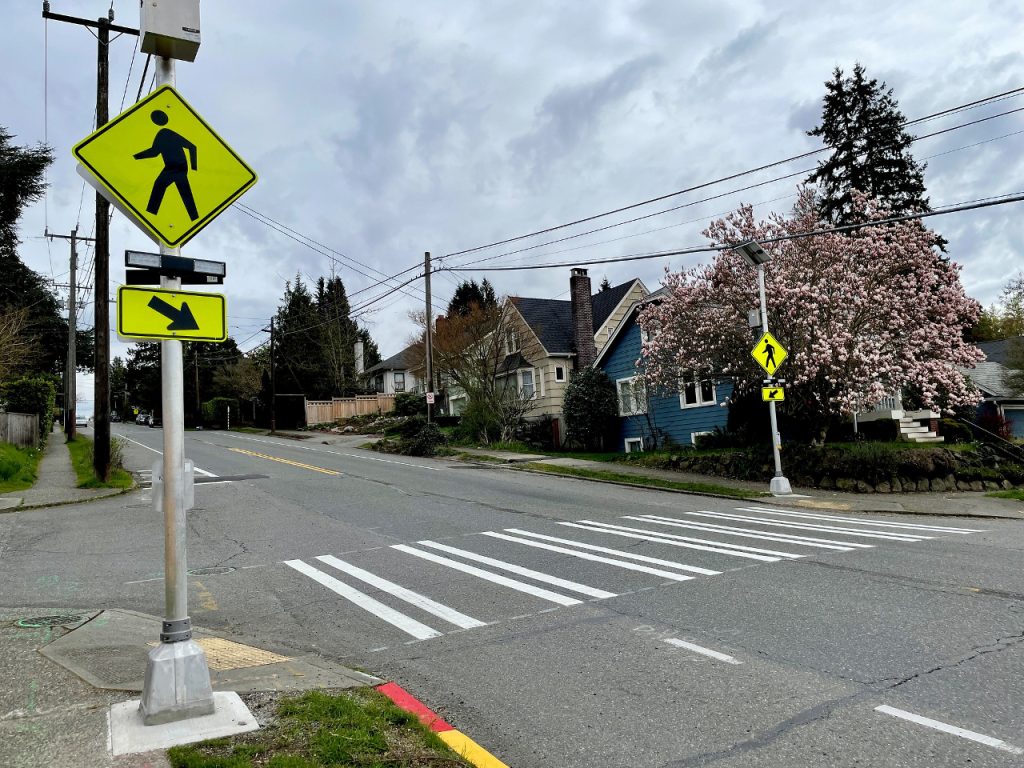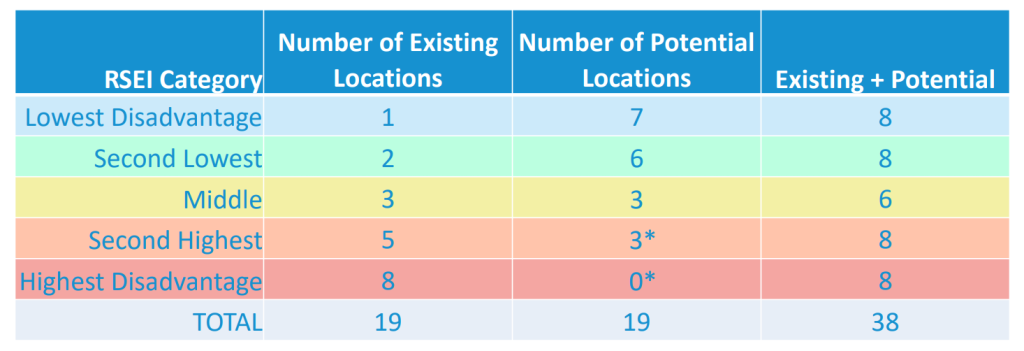
The chair of the Seattle City Council’s transportation committee is pushing back on a plan to expand the number of school zone speed cameras across the city, a proposal endorsed by a previous Council and set to be fully funded under Mayor Bruce Harrell’s 2025-2026 budget. The Seattle Department of Transportation (SDOT) has been developing a plan to design the new camera locations for well over a year, but Councilmember Rob Saka (D1, West Seattle), during a budget committee meeting Monday, suggested that the council might want to reconsider.
“I just want to make clear: I’m default skeptical of enforcement cameras that have the ability to just send you a ticket in the mail. I don’t support wide-scale deployment of those, and 16 net new school speed enforcement cameras across our city would, I think, rise to the level of approaching mass deployment of those,” Saka said.
The Harrell Administration’s proposal would actually add 37 new cameras at 18 schools by the start of the 2025 school year, more than doubling the current number of school zone cameras, which are only in place at around 20% of the city’s public schools. SDOT has touted its school zone camera program as a success story, citing an overall 71% reduction in crashes during times of day when cameras are active, and a 50% reduction in crashes involving people walking and biking at all times of day. Only 10% of drivers who receive a citation in a school zone receive a second citation, suggesting that the cameras play a significant role in changing behavior.

The idea of more than doubling the number of school zone cameras was initiated by former transportation chair Alex Pedersen, who left office at the end of 2023. Despite successfully adding an amendment to double the cameras in 2022, the amount of funding that the Council allocated was provided to the wrong city department, and came at an inopportune time as the Seattle Police Department (SPD) was struggling with fully staffing the unit tasked with reviewing camera footage and issuing tickets. Thanks to another change in state law, civilian public employees can now review camera footage, a change that was pushed for by the City of Seattle.
Questioning the current narrow focus of Seattle’s planned traffic camera expansion plan could be a reasonable move, given the fact that the state law surrounding traffic cameras has been given a substantial overhaul in recent years and camera locations that would previously have been prohibited are now legal. Speed enforcement cameras can now be installed along dangerous streets outside parks, hospitals, and along routes where students walk to school, where previously they were only allowed close to the school building itself. They can also be added to the most crash-prone intersections in the city where only red-light cameras were allowed before. At the same time, Seattle Public Schools is examining school closures across the city, though that closure plan has recently been walked back from more than 20 schools to just five.
But many of the issues raised by Saka this week seemed to be contradictory, or have already been taken into account by city staff. Saka’s transportation committee did not receive a briefing on the expansion of the school zone camera program at all this year, a fact Saka attributed to the fact that they were tasked with approving both the Seattle Transportation Plan and the city’s next transportation levy, work that had been concluded by early July.

Saka raised equity concerns about the placement of cameras, raising an example of a Title I school in his district that already has speed cameras in place, Louisa Boren STEM K-8.
“I think our approach needs to be guided by data. So there needs to be sound data for any potential location deployment of these cameras ” Saka said. “Also there are some important equity considerations: where are we deploying these cameras? Are they in areas that are already historically marginalized and underrepresented?”
Concerns around the placement of automatic cameras have come up before, with SDOT already tasked by the prior City Council with conducting an equity analysis on camera locations. As first presented last year, the current plan to increase school zone cameras would intentionally balance out the locations so that cameras are not concentrated the city’s lower-income neighborhoods. Currently, 42% of the existing school cameras are in areas with the “highest disadvantage” under Seattle’s Race and Social Equity Index (RSEI), with no new cameras proposed in those areas.

But Saka also suggested that neighborhoods that strongly advocate for cameras should also be prioritized. “If there’s strong community support for these type of cameras, that raises a special case, we need to strongly explore expansion,” Saka said, specifically citing Alki and Harbor Avenues in his district, where he has been responsive to community concerns following a deadly shooting earlier this year. But listening to neighborhoods with the most time and resources to advocate for themselves also presents equity concerns.
At the same time that he is questioning the city’s camera expansion plan, Saka has started pushing for the Washington State Legislature to expand authority for cities to deploy automatic cameras to enforce noisy street racing. At a meeting of the Puget Sound Regional Council’s Executive Board just last week, Saka pressed for the regional legislative agenda for 2025 to include such an ask.
“I would like to see the state consider, and ultimately allow [and] adopt some enabling legislation of some sort to allow for automated noise enforcement technology for cars,” Saka said, citing both the Belltown Hellcat and problem racing along Alki and Harbor Avenues. Saka has been a strong supporter of the idea of implementing CCTV cameras in many of these same locations, with the Council poised to adopt enabling legislation later this month that could pave the way for such infrastructure.

In some ways, Saka’s opposition to the camera expansion plan seemed to be based on the fact that it was approved by a previous Council without his input. “This is a significant policy choice that we are being confronted with here, and [the] last Council essentially approved, authorized cameras in every school, effectively,” Saka said. “What we are being asked to do is rubber-stamp a policy that was championed by a prior Council, and with the two-thirds new composition of this Council, I don’t know if that makes a lot of sense.”
Even with 18 new schools covered under the program, the city would be nowhere near having automatic cameras at every school, with over 60 schools still not included. During the meeting, Council President Sara Nelson, who had been involved in the discussions over Pedersen’s proposal to expand the camera program, spoke up in its favor. “It is an efficient way to keep children safe, and it’s one tool to meet our Vision Zero goals,” Nelson said, suggesting they talk about the proposal one-on-one.
In choosing to take a new path, the Council will also likely be turning down planned revenue from the cameras, expected to be $14.5 million over the next two years. Another plan to deploy cameras could also generate a similar amount of revenue, but they would essentially be asking the City to start over at square one.
Ryan Packer has been writing for The Urbanist since 2015, and currently reports full-time as Contributing Editor. Their beats are transportation, land use, public space, traffic safety, and obscure community meetings. Packer has also reported for other regional outlets including BikePortland, Seattle Met, and PubliCola. They live in the Capitol Hill neighborhood of Seattle.

